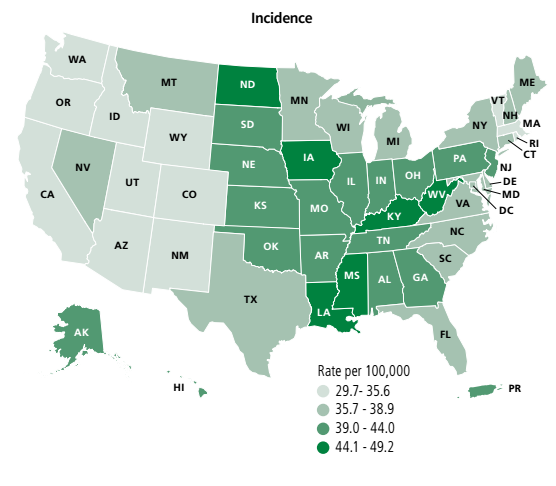March is designated as Colorectal Cancer Awareness Month. Often known as the “Preventable Cancer”, the key is in early screening and detection. According to the American Cancer Society, more than half (55%) of all CRCs in the United States are due to lifestyle factors. These factors include an unhealthy diet, insufficient physical activity, high alcohol consumption, and smoking. These lifestyle factors are typically associated with high-income countries, where CRC rates are highest. Worldwide, increasing CRC incidence is considered a marker of economic transition. Numerous studies have shown that people with healthy lifestyle behaviors have a 27% to 52% lower risk of CRC compared to those without these behaviors.
Typically, colorectal cancers start as precancerous polyps (abnormal growths) in the colon or rectum. These polyps or abnormal growths maybe present in the colon for long periods of time, even years before they move to becoming cancerous. In this early precancerous stage the polyps usually do not cause any symptoms in a patient. Screening for colorectal cancer can detect precancerous polyps so they can be removed before they turn into cancer. Screening for CRC remains lower than that for breast and cervical cancers despite the evidence supporting its effectiveness for reducing cancer incidence and mortality. Early detection of CRC allows for early treatment and better outcomes for patients.
According to the Center for Disease Control (CDC) colorectal cancer affects 4.4% of men and 4.1% of women. As with many forms of cancer, the risks associated with developing CRC, increases with age. By age 50 the incidence rate of CRC increases by approximately 30%. Interestingly, the median age of CRC patients are increasingly younger at age 66 where previously the median age had been 72. This change is attributed to increased incidence rates in younger adults while the incidence rates continue to decline in older adults. Some of this shift in age rate incidences is suspected to be related to obesity and other risk factors. During the five year time span from 2012 through 2016 the incidence rate increased by 2.2% in individuals under age 50.
In the United States today, the highest incidence rates of CRC are found in parts of the South, Midwest, and Appalachia and lowest in the West and Northeast. Current incidence rates range from 49 (per 100,000) in Kentucky to 30 in Utah, while death rates range from 18 in Mississippi and West Virginia to 11 in Connecticut and Utah. These regional differences are partly attributed to factors related to access to early detection and high-quality treatment.

Sources: Incidence – NAACCR, 2019. Mortality – NCHS, 2019
Beyond geography and lifestyle choices, another significant risk factor is heredity. Up to 30% of CRC patients have a family history of the disease, making this one of the most important and actionable risk factors. Knowing that a close family member such as parent, child, or sibling, has a history of this disease should be taken as an early warning sign to seek screening and testing while also working to maintain a healthy lifestyle.
Colonoscopy is the most commonly used CRC screening test in the United States. There are several recommended methods for CRC screening, including both visual examinations, which are performed at a health care facility, and high-sensitivity stool-based tests, which are collected at home. The American
Cancer Society and the US Preventive Services Task Force guidelines do not emphasize any one test and stress that all recommended tests can help save lives.
Computed Tomographic Colonography, also referred to as virtual colonoscopy, is gaining in becoming more widely known and used as an alternate to the traditional Colonoscopy. CTC is an imaging procedure that provides 2- or 3-dimensional views of the entire colon and rectum with the use of a
CT Machine. A full bowel cleansing is necessary for a successful examination, sedation is not required. CTC is less invasive than colonoscopy or sigmoidoscopy and typically takes approximately 10 to 15 minutes to complete. With advances in CT technology such as Cone Beam Computed Tomography (CBCT), super low doses of radiation are used in generating high resolution images for detection purposes.
The key to preventing, and reducing risk of CRC:
- Remaining Physically Active, avoid a sedentary lifestyle.
- Eat Health, and maintain a healthy weight.
- Avoid Alcohol and Tobacco consumption.
- GET SCREENED EARLY.
How Ultrasound Solutions plays a role in delivering diagnostic imaging equipment
USC understands the need to not only bring awareness and show support for CRC, but we are actively engaged in the fight. USC has committed representatives to bringing screening technologies for CRC such as CBCT and Ultrasound into rural communities in Appalachia and the South. Our representatives are based in Morgantown West Virginia, Springfield Tennessee, and Olive Branch Mississippi. We are a proud distributor of diagnostic imaging devices such as the Claris Cone Beam Computed Tomography system and X-Cube series Ultrasound machines with Single Crystal Transducer technology for the highest resolution images. These devices can be used in both the detection and treatment of CRC.
